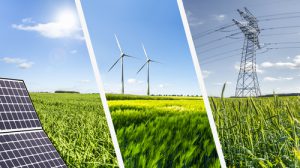By Joel Nelson on March 14, 2019 in Energy News
The U.S. Energy Information Administration (EIA) collects, analyzes and disseminates energy information. The following items are drawn from recent postings on EIA’s Today in Energy news site. 
Consumption Rates Slow
The EIA’s energy outlook report for 2019 projects that residential and commercial purchased electricity consumption will grow more slowly than the number of households or total commercial floor space. As a result, electricity intensity—the amount of electricity consumed per household or square foot of commercial floor space—will decrease by an average of 0.3% per year and 0.4% per year through 2050 in the residential and commercial sectors, respectively. The number of households will grow an annual average of 0.7% and total commercial floor space by 1% per year during that period.
The projected rates are much lower than what occurred from 1990 through 2018, when electricity sales grew at average annual rates of 1.7% in the residential sector and 1.8% in the commercial sector. The growth slowdown stems in part from improvements in technology and federal energy efficiency standards for space heating, cooling and water heating equipment, appliances and items such as light bulbs.
Electricity’s New Generation
An EIA short-term energy outlook released in January forecasted that wind, solar and other non-hydroelectric renewable energy resources will be the fastest-growing sources of U.S. electricity generation for at least the next two years, Wind generation will grow by 12% and 14% in 2019 and 2020 and utility-scale solar generating units by 10% and 17% over that period.
About 23.7 gigawatts (GW) of new capacity will enter the U.S. electric power sector in 2019 alone. Wind accounts for 46% of those utility-scale additions, followed by natural gas (34%) and solar photovoltaics (18%), with the remaining 2% consisting primarily of other renewables and battery storage capacity.
New small-scale solar photovoltaic capacity totaling 3.9 GW from sectors such as residential and commercial is also expected to enter service in 2019.
Renewables Get New Wind, but Fossil Fuels Still Lead
The short-term outlook report also projected that the share of total U.S. electricity generation produced by all renewables other than hydropower will increase from 10% of total generation in 2018 to 13% in 2020.
EIA reported in September 2018 that hydroelectricity was the U.S.’s highest renewable electricity generation source in 2017, providing 7% of the national total, with wind generation expected to surpass it in 2019.
Even with the growth from renewable energy sources, fossil fuels still provide most of the electricity generated in the U.S. Coal and natural gas provided 63% of electricity generation in 2018 and are expected to provide 61% in 2020.
Law Extends Energy Support
The Agricultural Improvement Act of 2018 was signed into law in December. It continues federal support to a number of renewable electricity and bioenergy-related programs, facilities and technology for fiscal years 2019 through 2023.
Energy programs will receive $375 million in mandatory funding over that period, and up to $860 million more in potential discretionary funding. The bill reauthorized most Title IX programs, which consist of project grants, guaranteed loans and direct payments. Most of the Title IX funding is earmarked for the Rural Energy for America Program, which promotes the installation of renewable energy systems, particularly solar and energy efficiency retrofits, for agricultural producers and rural small businesses.
U.S. Poised to Grow Exports
The EIA’s latest annual energy outlook report anticipates that the U.S. will become a net exporter of petroleum liquids in 2020 as U.S. crude oil production increases and domestic consumption of petroleum products decreases. The country will continue to be a net exporter of natural gas and coal (including coal coke) through 2050.
U.S. liquefied natural gas exports and pipeline exports to Canada and Mexico will increase until 2030 and then flatten through 2050 as relatively low, stable natural gas prices make U.S. natural gas competitive in North American and global markets.
Meanwhile, increasing energy efficiency across end-use sectors will keep U.S. energy consumption relatively flat, even as the U.S. economy continues to expand.
Cold Drives Midwest Demand
Extreme cold weather in the nine-state Midwest region in January led to a high electricity load on Jan. 30, the coldest day of the period. Consumption of natural gas, the region’s main fuel for heating, reached a single-day record high.
The January polar vortex was significantly colder than weather events in 2018 and 2014. However, peak electricity loads were lower than expected because of the deployment of load-modifying resources such as demand response, other voluntary load management actions, stored renewable energy capacity, and widespread closures of schools and businesses.
Read more Today in Energy updates.


